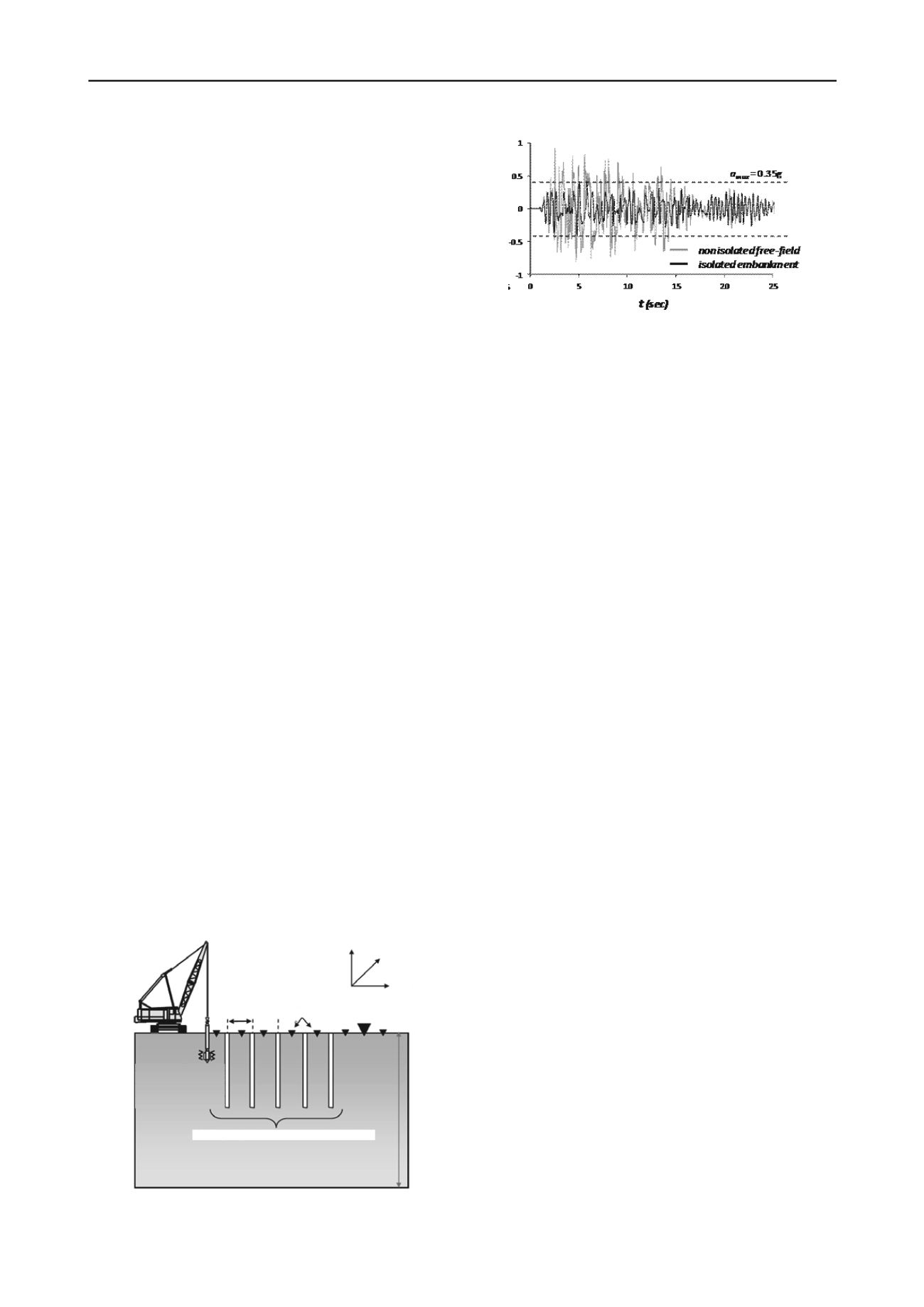
1395
Technical Committee 203 /
Comité technique 203
We can notice that the displacement is much smaller with a
column height of 10 cm (maximum displacement: 0.6 mm) that
with a 5 cm height (maximum displacement: 1.0 mm).
Consequently, thick soft columns must be chosen in order to
reduce the forces in the rigid part. Finally, the results indicate
that the footing bearing capacity with CMM increases and a
large amount of the seismic energy is dissipated within the soil
column.
Lambert also discusses the interest and implementation of
stone columns (paper #1886). The three main effects are:
increase of the Cyclic Resistant Ratio due to the higher soil
compacity, reduction of the Cyclic Stress Ratio due to the stress
concentration in the stone column and fast decay of the pore
pressure due to the high permeability of the gravel. The results
depend on the geotechnical conditions at the site: for silt, it is
possible to reduce the potential risk of liquefaction by primarily
considering the drainage and the effect of stress concentration,
whereas for sand the predominant action is compaction. The
design of stone columns is also discussed at the end of the
paper.
In paper #2080, Usmanov shows that the water saturation of
the soil contributes to the transition into the category of weak
and high compressibility. To improve the bearing capacity and
reduce the compressibility of soils, high-condensed soil pillows
are studied. Their efficiency is shown to be very good but their
thickness should not be less than 0.75 width of the foundation.
Usmanov also investigates vertical sandy drains to improve the
behaviour of weak water-saturated loess. These results allow to
improve the design and construction of buildings and structures
in seismically active areas involving such soils.
7 SEISMIC ISOLATION
Two papers are proposed in the field of seismic isolation: one
on seismic wave screening (#1676) and one on seismic isolation
at the foundation system (#2153).
In paper #1676, Brûlé et al. proposes field experiments to
assess the efficiency of a wave screening system. The test site is
located is the Grenoble area in homogeneous thick clayey soils
(the layer depth has been estimated around 200m). As shown in
Fig.12, the system consists in modifying the global properties of
the soil by using a grid of vertical, cylindrical and empty
boreholes (spacing 1.73m). They are 5m deep and their
diameter is 320mm. The excitation is generated around 50Hz by
a vibroprobe and velocimeters are displayed along the free
surface (Fig. 12). The surface wave velocity at the site is found
to be 78 m/s leading to a wavelength of 1.56m near the source.
The experimental results lead to a very strong energy abatment
between the second and third rows. The efficiency of the
screening system is thus very good and the perspective is now
to investigate lower frequency ranges.
velocimeters
regularly spaced empty cylindrical columns
vibroprobe
clayey soil
velocimeters
Figure 12. Principle of the wave screening system and experimental set-
up (Brûlé et al., #1676).
Figure 13. Standard pier response (acceleration) vs pier response with
application of the in-soil isolation system (Tsatsis et al., #2153).
A different isolation method is proposed by Tsatsis et al.
(paper #2153): a sliding surface comprising two synthetic liner
layers is introduced within the foundation soil. The contact
between both layers generates some friction and dissipates a
significant energy amount. To assess the efficiency of the
method, a soil-embankment-pier system is studied numerically.
The geometry of the isolation system is trapezoidal, with
isolated wedges on the two sides. The synthetic liners are placed
at a depth H = 2 m under the surface. The isolated embankment
comprises a dense gravel layer (modelled with a nonlinear
constitutive model). The two wedges are filled with pumice, a
lightweight material of relatively small stiffness (
E
= 10 MPa)
in order to impose the minimum possible resistance to the
sliding motion of the embankment. The superstructure, an
idealized bridge pier (for simplicity), is placed on top of the
isolated embankment. As shown in Fig.13, the proposed system
serves as a fuse mechanism within the soil and substantially
reduces the acceleration transmitted onto the structure.
8 PILES/FOUNDATIONS
Five papers are dedicated to foundations and SSI. They mainly
concern pile foundations.
Gudavalli et al. investigate 1,355 open-ended piles in dense
to very dense sandy soils (paper #2072). These piles are driven
down to 10 m and 30 m. The PLR (plug length ratio) values
increase with the pile diameter: from 0.76 for 406mm-diameter
piles to 0.91 for 914mm-diameter piles. The authors propose an
equation giving the PLR as a function of the pile inner diameter.
The unit skin friction and unit end bearing values are estimated
by performing dynamic load tests (PDA) and signal matching
analyses (CAPWAP) on 99 piles. These parameters are found to
increase with decreasing PLR. New equations to estimate the
skin friction factor
and end bearing factor
N
q
from the PLR
are thus proposed for dense to very dense sands.
Yang presents a performance-based Limit States Design
(LSD) approach involving detailed soil-foundation-structure
interaction analyses for the Golden Ears Bridge in Vancouver,
Canada (paper #2441). Soil-foundation-structure interaction
analyses involve both global bridge structural seismic modelling
and foundation substructure modelling such as:
The nonlinear load-displacement response of foundation-soil
systems is modelled by hybrid pile group techniques leading
to the results displayed in Fig.14.
The radiation damping of foundation-soil systems is
modelled in the form of viscous damping (Novak, 1974).
The bridge and foundation seismic response are modelled by
dynamic time domain FEM computations (Adina) and
hybrid foundation models under pseudo-static seismic loads.
The results from full scale Osterberg-Cell tests are
incorporated in the models.
The results from full scale tests (Osterberg-Cell and pile load
tests) are analyzed in the framework of the performance-
based foundation design.
The results of the nonlinear time history FEM analyses show
that important soil-structure interaction effects reduce the


